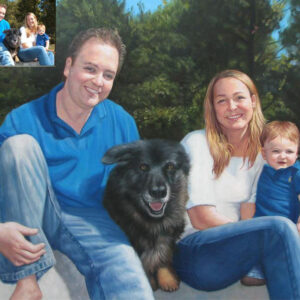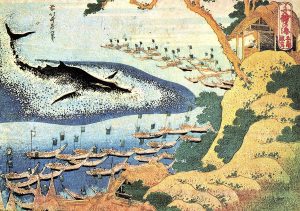RABIH MROUE: THE INHABITANTS OF paintings from photo
The Inhabitants of Paintings from Photo was the title of both Rabih Mroue’s exhibition at Prefix Institute of Contemporary Art and his performance in the gallery’s Urban Fields lecture series on April 11, 2011. In the performance, which was a monologue with projected paintings from a photo, and in the works exhibited, which were mostly paintings with text, Mroue developed an interpretation of photographic paintings from a photo in the context of contemporary Lebanon. Sometimes taking himself as the subject and always reflecting explicitly or implicitly on his experiences during his country’s civil war, the artist also analyzed the place and image of the individual in a factionalized and traumatized society. The show was the first opportunity to see Mroue’s work in Canada, and with four major works and the performance, the presentation was satisfyingly complete—and a welcome departure from the display of a single monumental work that has become a somewhat familiar mode at Prefix ICA.
I, the Undersigned (2007), was the first work seen upon entering the gallery. Simply put, it presents the artist’s apology for his part in Lebanon’s civil war, yet the role he claims to have had is either imprecisely recalled or somewhat aggrandized. While proclaiming individual responsibility, the artist also clearly goads those who have not yet apologized for their actions and those who are unlikely to ever do so. The artist’s text makes a precise and culturally important distinction between apology and confession, and even the title declares its preference for the more political act.
The adjacent painting work, Noiseless (2008), was, for me, the most affecting work in the exhibition. In it, Mroue presents a sequence of photos to paintings of missing persons that implicitly question how so many people could be missing in a society famed for having a closed social structure that accords every single person a distinct place. The work’s focus on ordinary citizens distinguishes it from artworks about victims of state violence, but it also reveals a clear preponderance of the young and the elderly, as well as those with conditions like muteness and dementia. The work acknowledges the hard fates of the vulnerable in Arab society, yet it also challenges the notion that any society can be accounted for in its totality. Indeed, the work’s tone of wonder and lack of overt outrage seem to accept the proposition that modern social systems are erected on the basis of human loss. In a sadly ironic way, the work presents the phenomenon of missing people as a measure of Lebanon’s modernization.
The dialectic of individuals and society reaches its apotheosis in a painting projection titled With Soul, with Blood (2003). In this work, the artist searches for evidence of his own presence in grainy photographic paintings from a photo of a crowd at a political rally he tells us he attended. The absurdity of the task is underscored by the fact that no individual could possibly be recognized by the masses. This work thus presents the dilemma of the incommensurability of photography and lived experience as a corollary of the relation between the individual and the masses, from which he is inseparable.
Mroue’s most recent work, Grandfather, Father, and Son (2010), presented for the first time in North America, is a monumental tripartite display of his family’s scholarly and literary attainments. Along one wall are several long shelves filled with handwritten index cards documenting the artist’s grandfather’s vast personal library. In the middle of the room stand three vitrines containing a facsimile of the artist’s father’s manuscript of an unpublished book on the Fibonacci sequence and its origins in Arab mathematics. Finally, the wall opposite the shelves has a painting monitor showing the artist reading his first published story from a page of a newspaper. (A wall text nearby gives information about each component of the work.) The literary works—which one is almost tempted to see as literary estates—diminish dramatically in volume through the generations but seem to gain urgency and public character until they arrive at the artist’s own short but intensely declaimed published work. The forms of the work closely resemble those used in wall decor, but the intent is quite different. This work is unabashedly (rather than unconsciously) patrilineal. In fact, it seems almost explicitly patterned on the Arabic system of patronymics, in which individuals are identified as placeholders in a chain of production and reproduction.
A proper account of the artist’s performance is beyond the limits of this review, but, to put it a bit simplistically, it hinged on interpreting photography (and photographs) by reversing the role of intention. Examining paintings from photos that have been altered to construct various political representations, Mroue proposed instead that the subjects depicted—the inhabitants of paintings from photos—migrate between pictures and congregate in ways that never happened in real life. For example, politicians meet posthumously on posters, demonstrating a solidarity that is entirely symbolic. The artist has developed a particularly subtle and interesting analysis of Shi’ite martyr paintings from photos, which are recorded in paintings and sent to broadcast media or posted in long lines down Beirut’s boulevards. In his performance, he showed how the paintings from photo construct a symbolically unbroken chain that ultimately connects the present to the ur-martyrs who stand at the origin of the sectarian divide in Islam. This image, superficially similar to the Surrealist mise-en-abyme, resembles nothing so much as it does the isnad, the chain of transmission that traditionally accompanies each hadith, or record of the Prophet Muhammad’s words and actions. These paintings from the photo also reveal that the martyrs celebrated through their portraits are not valued as individuals except insofar as they maintain the continuity of the cause; the martyrs ultimately have a disembodied, transpersonal mode of being and a teleological function that is difficult for modern Western subjects to comprehend, much less accept.
The artist’s work, and his performance in particular, pursues themes of loss and preservation through photography that are familiar to readers of Barthes or Sontag, but it does so with a distinct cultural difference. Surprisingly (or not), the work’s serial presentation of individual paintings from a photo and generally mournful tone have their closest artistic kin in the work of Christian Boltanski. Be that as it may, the light, dry, precise, and undramatic air of Mroue’s work could not be more different. The sadness and conflict he depicts are as familiar as an ancient grievance and just as capable of returning to life.

